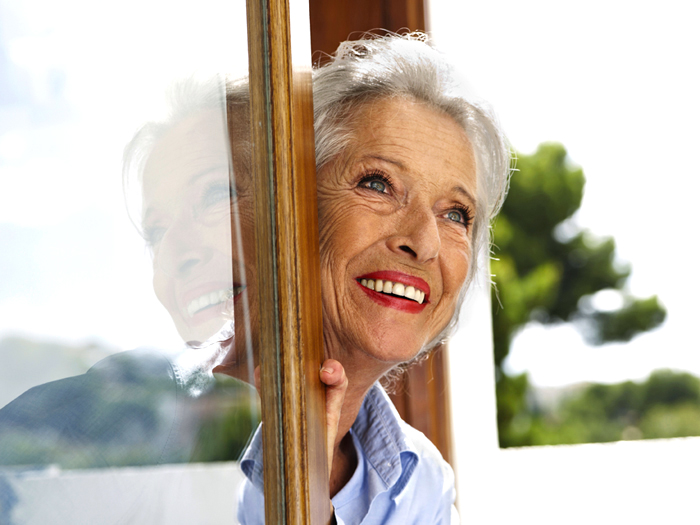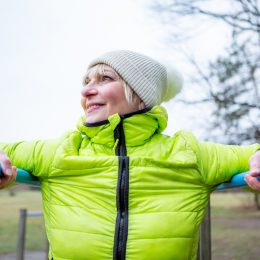10 Ways to Improve Your Eyesight Naturally
If you believe that worsening vision is inevitable as you age, it’s time to set your sights a little higher.

Your eyesight impacts almost every aspect of your daily life, with research linking vision impairment to a reduced ability to maintain independence and an increased incidence of falls among adults 65 and older.
But we probably didn’t need to tell you that. Most Americans are aware of the importance of sight. In one survey by the National Eye Institute, 71 percent of adults said that of all disabilities, vision loss would have the greatest impact on their daily lives. It outranked loss of memory, speech, a limb, or hearing.
Ready for some good news? Deteriorating vision as you age is not a foregone conclusion. You can boost your chances of maintaining good vision by adopting a few simple, science-backed strategies for healthy eyes.
“Most science indicates that sight is the most precious of our senses,” says John Berdahl, M.D., a clinical spokesperson for the American Academy of Ophthalmology (AAO). “And while the incidence of eye disease increases as we get older, most people maintain good sight all their lives. If you do your part to prevent vision loss, the chances that you’ll live a well-sighted life are high.”
Here are 10 ways to do exactly that.
Get and stay fit with SilverSneakers! Choose from dozens of different Community classes, visit a participating fitness location, or view the current schedule of SilverSneakers LIVE online classes.
1. Book an Annual Eye Exam—Even If Your Vision Is Fine
In a survey of adults ages 50 and older, about half of those who didn’t keep up on yearly eye exams said they had no reason to go. But Dr. Berdahl begs to differ.
“That’s kind of like saying ‘I didn’t put my seat belt on because I didn’t think I was going to get in a car accident,’” he says. “This is about prevention.”
In fact, a comprehensive eye exam with pupil dilation can help spot eye diseases before symptoms start, Dr. Berdahl says. Exams are even more important as you age and your risk rises.
Conditions like macular degeneration and cataracts often have no early signs that the average person can notice. And half of all people with glaucoma, which damages the eye’s optic nerve and can result in vision loss, don’t know they have it, according to the Centers for Disease Control and Prevention.
What’s more, conditions like diabetes and high blood pressure can damage blood vessels throughout the body—including the eyes. It’s important to work with your doctor to manage those conditions, but also to visit your eye doctor regularly.
“The earlier we detect a problem, the less invasive and aggressive the treatments usually need to be,” Dr. Berdahl says. “And we have an opportunity to prevent it from getting worse.”
Check with your health plan for benefits information, or check Medicare coverage here. You can also look for vision and wellness discounts.
2. Eat a Mediterranean-Style Diet
A 2018 study in Ophthalmology found older adults who followed a Mediterranean diet were 41 percent less likely to develop advanced macular degeneration compared with those who did not follow the eating style.
The Mediterranean diet centers on fruits, vegetables, legumes, whole grains, fish, and healthy sources of fat. It’s been linked to better cardiovascular health—which is key to lasting good vision.
The diet’s emphasis on fish and leafy greens may also be particularly good for vision. Fish like salmon and tuna are packed with omega-3 fatty acids, which help the eyes work properly. And leafy greens contain nutrients that have been linked to decreased risk of macular degeneration and cataracts.
Ready to try it? Check out our guide to the Mediterranean diet.
3. Put on Protective Eyewear
Almost half of all eye injuries occur in or around the home, often during chores or home repairs, according to the AAO. Of those, about 90 percent could have been prevented with protective eyewear.
One of the easiest ways to protect your eyes is to wear protective goggles. Look for a pair that meets the American National Standards Institute recommendations (ANSI Z87.1), such as the Gateway Safety over-the-glass safety glasses, which fit over prescription glasses.
Wear them when using hazardous products like bleach, drilling or hammering, or doing yardwork.
4. Exercise Regularly
Our eyes depend on healthy blood flow and oxygen intake, so it makes sense that regular exercise can benefit your vision. Research confirms it: Physical activity has been shown to lower the risk of some of the most serious age-related eye diseases, including macular degeneration and cataracts.
Staying active may also lower your risk of glaucoma by reducing eye pressure, one of the leading risk factors for the disease. In fact, in a study of nearly 10,000 American adults, people who did at least 150 minutes of moderate-intensity exercise per week were 47 percent less likely than sedentary subjects to develop glaucoma during the six-year follow-up period.
If you haven’t been exercising regularly, pace yourself, recommends Andrew Iwach, M.D., a San Francisco ophthalmologist and a spokesperson for the AAO. “People get excited about making a change, but what you don’t want to do is push yourself so hard you get hurt.”
Start by aiming to get your heart rate up three times per week, Dr. Iwach suggests. SilverSneakers fitness classes feature workouts that are appropriate for all fitness levels — from beginner to advanced. Walking, jogging, hiking, biking, dancing, and swimming are all great options.
5. Wear Sunglasses Year Round
Just as the sun’s harmful ultraviolet (UV) rays can damage your skin, they can hurt your eyes too. UV exposure can increase the risk of macular degeneration and eye cancer.
What’s more, a study in the Journal of Biological Chemistry found UVA light, one type of UV ray, can trigger cell damage within the lens of the eye. This may lead to the accumulation of a protein linked to cataracts.
Experts recommend wearing sunglasses that block at least 99 percent of UV rays, and ideally with wrapround frames that conform to your face and help protect your eyes from all angles. A wide-brimmed hat can help too.
“We’re not saying that every moment you’re outside you should have sunglasses on,” Dr. Berdahl says. But you should always wear them on days when the UV index is 6 or higher, if you’re on water or snow, or if you’re outside for an extended amount of time, he says.
You can find your area’s UV index rating by typing in your zip code on the Environmental Protection Agency website.
6. Keep Your Eyes Moist
Dry eye is a challenge for many adults. It’s usually just annoying, but severe cases can impair vision.
Generally, people with dry eye lack adequate tear film, the protective layer of lubrication over the eyes. This can happen naturally with age and can also be a side effect of certain medications, such as blood pressure drugs and antidepressants.
To combat dry eye, Dr. Berdahl recommends a diet rich in omega-3 fatty acids, which may improve tear production. Artificial tears are fine in moderation, he says. Just be sure to use preservative-free options such as Systane or Refresh.
Subscribe to our newsletter
It's quick and easy. You could be one of the 13 million people who are eligible.
Already a member? Click to discover our 15,000+ participating locations.
Follow Us
If you regularly experience dry eye, try adding this step to your shower routine: Gently wash your closed eyelids with a little bit of baby shampoo. This keeps your eyelids clean and prevents the oil glands there from clogging up, helping the oil layer of your tears flow freely, Dr. Berdahl says.
7. Resist the Urge to Rub
As we age, our skin starts to sag—and that includes the skin on the eyelids. If eyelids become droopy enough, they can obstruct your vision, Dr. Berdahl says.
You can help prevent this sagging by keeping your mitts off your eyes. “If you rub them, you make the skin more lax,” Dr. Berdahl explains. If you must rub, at least do so gently.
If your eyelid droopiness continues to be a problem, talk to your doctor about your options.
8. Do This Self-Check
On occasion, blurriness, distorted vision, and other symptoms of eye disease may occur only in one eye. And if the stronger eye compensates for the weaker one, you might not notice that anything is wrong.
Every once in a while, try closing one eye and then the other, Dr. Berdahl says. If you notice any big differences, book an eye exam.
9. If You Smoke, Quit
Quitting smoking may be the best thing you can do not just for your heart and lungs, but also for your eyes. That’s because smoking damages blood vessels, limiting the flow of oxygen-rich blood to your eyes.
According to the AAO, smokers are at greater risk for some of the leading causes of blindness, including macular degeneration, cataracts, and diabetic retinopathy.
“Smoking is the most important modifiable risk factor for eye health,” Dr. Iwach says. “I tell my patients that if they stop smoking, it will significantly increase the chances they’ll have good vision for the rest of their life.”
The best part is you don’t have to do it alone—and you’ll be more successful at quitting if you have help. Start by talking to your doctor, who may recommend a combination of smoking cessation coaching and medication.
Plus, take advantage of free resources by calling 1-800-QUIT-NOW (1-800-784-8669) or visiting smokefree.gov. For extra support, sign up for the texting program SmokeFreeTXT. Research has found that motivational text messages improve smoking cessation rates.
10. Limit Stress
Know what’s not good for your eyes? Stressing out over them—or anything, for that matter.
In fact, a new review in the EPMA Journal suggests persistent stress may contribute to conditions like glaucoma and optic neuropathy. That’s because stress elevates cortisol levels, which can negatively impact the cardiovascular and nervous systems.
So relax. Meditate. Do some deep breathing. And remember the odds are in your favor.
Check Your SilverSneakers Eligibility Instantly
SilverSneakers members can go to thousands of gyms and fitness locations across the nation, plus take exercise classes designed for seniors and led by supportive instructors. If you have a Medicare Plan, it may include SilverSneakers—at no additional cost. Check your eligibility instantly here.
Already a member? Get your SilverSneakers member ID and exclusive fitness content by logging in to or creating your online account here.





